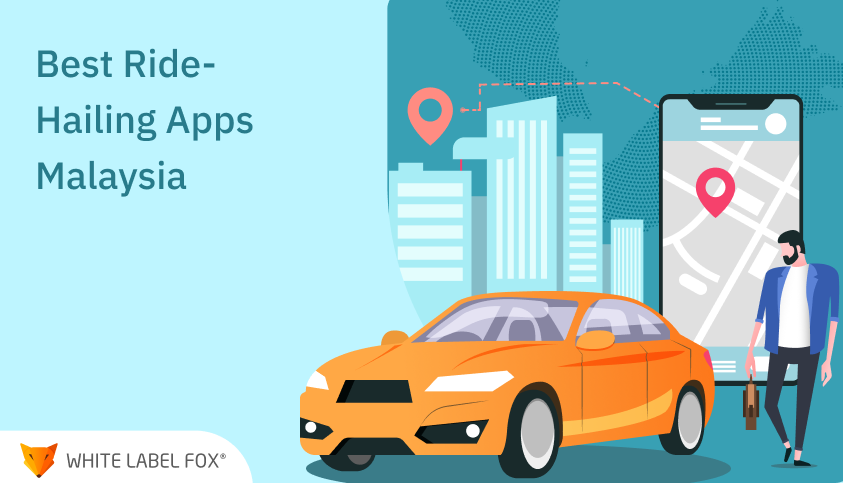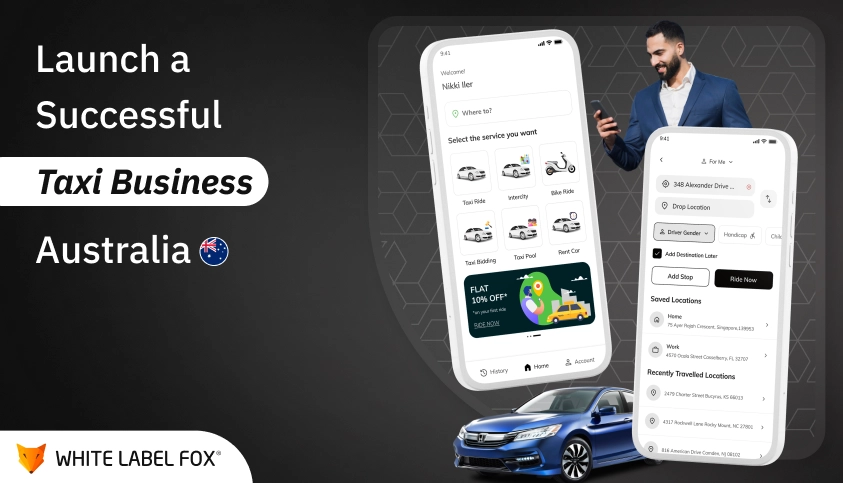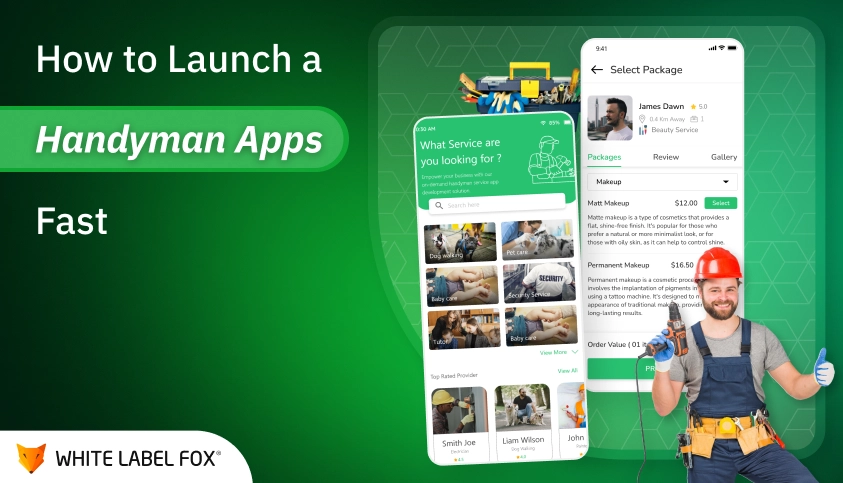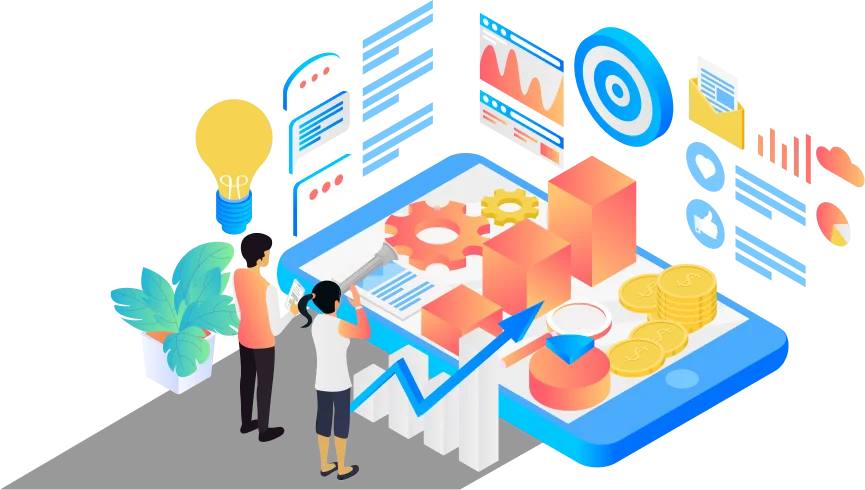Are you a startup with an online delivery app development approach, or are you an entrepreneur who requires a grocery delivery app to become a market leader? Due to the pandemic spread, you need to keep in mind the sanitization, social distancing, and other factors in consideration for online grocery app development. In the blog, we have discussed the major takeaway in helping you build an app like Instacart, check how you can take the lead on the market with a grocery delivery app solution.
The COVID-19 pandemic has brought on-demand grocery, a promising niche sector, to the fore. The combo of customers’ interest in eliminating public places and the continued demand for groceries and essential goods has made on-demand grocery delivery services such as Amazon, Instacart, Walmart, and many more popular.
The online grocery shops can keep customers throughout the COVID-19 pandemic spread to keep shoppers for the foreseeable future. Business Insider survey, more than 75% of grocery shoppers shop their first-ever online provider. Online grocery ordering and delivery apps satisfy the customers’ requirements during the COVID-19 pandemic.
Most customers resist shopping because they require to pick out the groceries and avoid extra fees. However, the covid-19 pandemic has forced them to change their priorities; the student focus on online grocery is set to alter customers’ purchasing behavior after the pandemic subsides, stimulating the industry’s penetration in the US.
Why Invest in Grocery Delivery App Development?
The online grocery eCommerce has a moment as more customers get in the habit of shopping online. The pandemic has shifted to eCommerce, and that is more apparent in the grocery category. On-demand grocery sales are estimated to increase by 53% in 2020; that market is estimated to reach around $89.22 billion in sales, showing growth of $30.86 billion from the previous year.
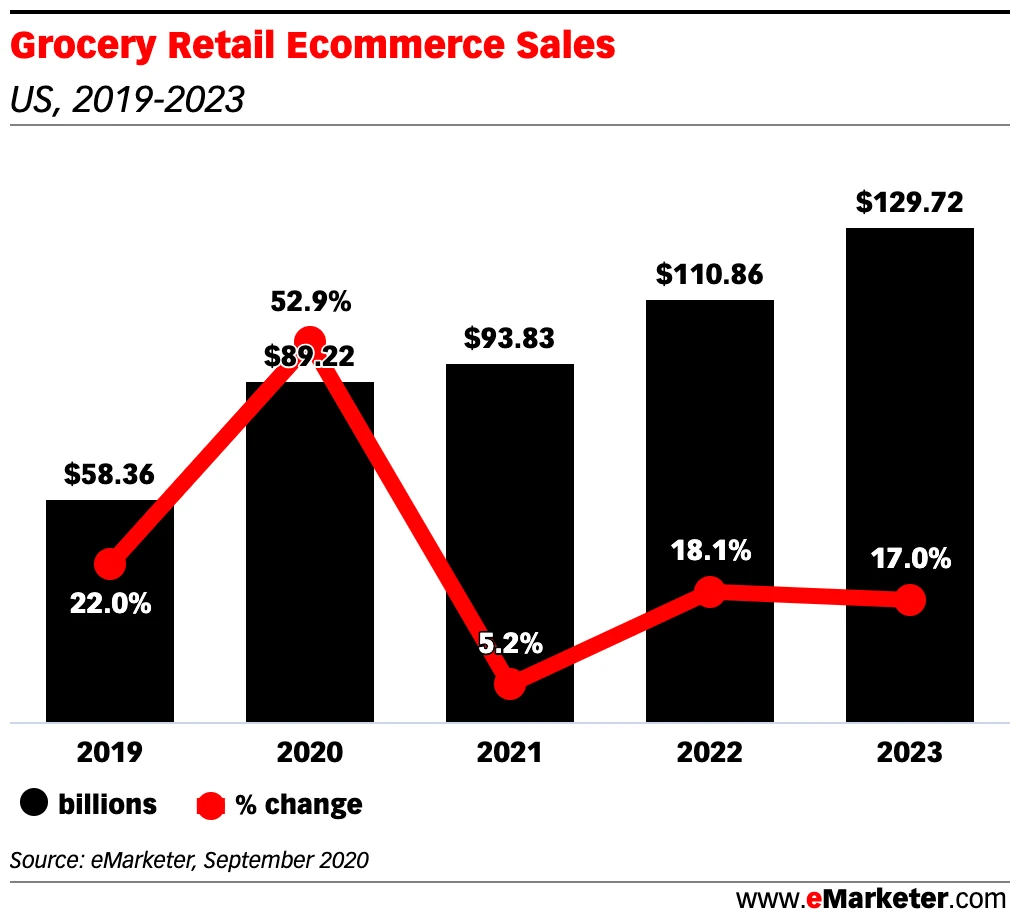
Online grocery sales are forecasted to reach around $129.72 billion by 2023, accounting for 10% of total grocery sales. However, online spending for the grocery delivery sector remains high, and the number of people who try digital grocery services is higher. More and more customers are getting technically advanced, and using an app for grocery shopping is becoming a norm
Do You Want To Start Your Business For Grocery Delivery?
Let's Discuss Your Grocery Delivery Business Idea!
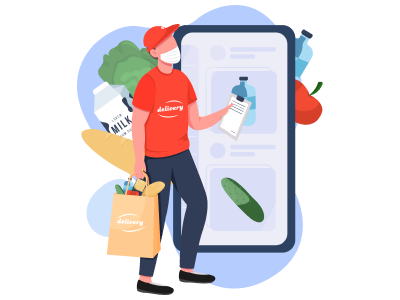
Online shoppers are increasing; the niche has experienced a tremendous increase via on-demand grocery delivery mobile platforms. More people these days are commending the idea of ordering and getting fresh household items at any time they want.
All these things happen without the necessity of visiting the physical store, or remaining in the queue while billing. However, this is the primary reason for a drastic increase in online shoppers. Many tech companies are taking an interest in investing in a grocery delivery mobile app.
How Does an App Like Instacart Work?
The overall functioning of an app like Instacart is quite simple. It provides all sorts of grocery items and facilitates users to apply specific filters to make searching faster. After browsing, users can add required items to their cart and move to the final checkout process.
Users are also allowed to schedule requests for the same; check the following steps to know how the grocery delivery app works:
- Users, grocery shops, and delivery providers must register themself with the delivery platform;
- After sign-up, users can browse items and place orders;
- Grocery store receives the order with the option to accept or reject it;
- Grocery store after packing the order, hand it over to delivery provider;
- The delivery provider delivers the items to customers doorsteps;
- Customers receive the ordered things and make payment;
- Customers can review and rate delivery and service providers.
Market Leaders of Online Grocery Delivery
Online grocery delivery is the best option for people who do not have time to go shopping and stand in long queues for purchasing groceries. During the COVID-19 pandemic, grocery delivery is the best option for those who don’t want to leave their houses. And before developing a grocery delivery app, it becomes crucial for you to have basic details about the market leaders and their working process. Check the list of market leaders right away.
Walmart Grocery Delivery
Walmart Grocery is the leading grocery delivery service. It offers services in around 1,600 cities worldwide; it was launched in 2015 and later expanded its operations in the United States, Canada, South Africa, and many more.
How Walmart Works
You can download the Walmart Grocery app on your smart device or visit the website. The delivery platform provides users with a wide range of items to browse and order right away. Walmart also provides the pickup option besides doorstep delivery; after browsing the item, users can even choose to schedule the delivery as per their convenience.
Instacart
The on-demand delivery platform, the grocery delivery platform facilitates doorstep grocery deliveries and other home essentials in most cities in the USA. The technology-driven business model of the grocery delivery app helps to deliver groceries to customers. It is one of the most futuristic and promising companies which is based on the shared economy model.
The grocery delivery startup has gained massive popularity in the on-demand sector. Looking to the success of Instacart, many entrepreneurs are eager to know about the grocery delivery giant business model and looking forward to investing in Instacart clone script that helps them manage every business operation efficiently. Let’s check more to know how Instacart works and generates revenue, and Instacart is valued at 2 billion in 220 million fundraisings.
Instacart Business Model: Check to Know How it Works?
Instacart is a leading on-demand grocery delivery brand that has achieved massive success due to its efficient and unique business model. Due to its tremendous growth and stable operating model, Instacart is a favorite for most investors. Many investors seek a grocery app development company to build an Instacart clone script, helping them automate their business operations and quickly boost their business growth.
In the last round, Instacart raised $600 million at a $7.6 billion valuation. More than 85% of United States and 60% of Canadian households prefer to use an app like Instagram for grocery purchases. The online delivery platform operated on a sharing economy-based business model. It offers hyper-local on-demand grocery delivery by connecting shops with customers. Instacart doesn’t have any store; it offers a platform for grocery shoppers to sell their products online.
Business Model Canvas: Check the Update Here!
In 2019, the grocery market will surpass $190 billion. However, the market is predicted to increase at 28% of the CAGR between 2020 and 2026. Due to the COVID-19 pandemic and subsequent lockdowns, online sales in online stores start exploding; it’s a surge in demand. Online grocery delivery became safer to purchase crucially as opposed to visiting crowded stores during tough times.
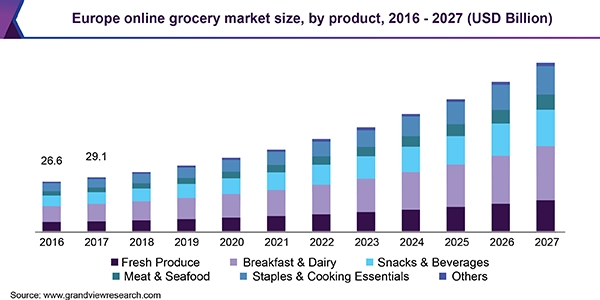
The online market is segregated into fresh produce, dairy, breakfast, snacks & beverages, meat and seafood, and many others based on product type. Modern-day technology has made grocery purchases easier. Looking to build your business in North America and other regions? Have a look at our Instacart clone script solution.
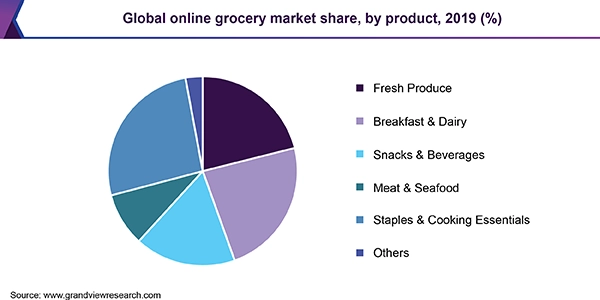
Users can use the Instacart clone script to order groceries and deliver them to their doorsteps within an hour. The grocery delivery platform enables users to purchase groceries right from the comfort of their homes. All the customers need is to create an account, select the product, and schedule delivery to assemble their order and facilitate home delivery. It enables an in-store pickup and saves the trouble of walking through the stores growing for the desired products.
Instacart Revenue Model: Check How Grocery Delivery Provider Makes Money?
Are you wondering how Instacart makes money? Then find the answer right here. Instacart generates revenue from multiple channels, and the revenue model includes ways like delivery fees, payment from grocery partners, placement fees, and surge prices. Have a deep insight into it.
Delivery Fees
The grocery delivery app charges delivery fees from customers. The delivery fees are not fixed; it ultimately depends on order quality and distance of delivery as well.
Mark Up
As per the company, it cost the same as in-store charges. For example wholefood charge, while the grocery platform charges around 15% markup from some trailers.
Grocery Partner Payments
Instacart charges fees from the registered grocers. The grocery delivery company charges some percent from grocery shops; the company charges nearly 3% on every order from grocery stores. It is the fee for tackling the advertisement and order process.
Placement Fees
Besides the above-listed revenue generation methods, you can also consider making money by levying placement fees charged to the manufacturer through an app similar to Instacart.
Investing in Instacart Clone Script: Smart Move to Boost Business Growth
The Instacart business & revenue model is proven suitable for grocery startups with a unique business plan and approach. And if you want to start your grocery delivery app like Instagram, the business structure is worth implementing.
A feature-rich platform and website can be considered a crucial aspect of starting a grocery business. You can either invest in a ready-to-use Instacart clone or choose to develop custom app development at an affordable cost. For further details, contact us at [email protected].
Frequently Ask Questions
A Grocery Delivery App Solution is a platform that allows users to order
groceries online and have them delivered directly to their doorsteps.
The solution connects users with local grocery stores or delivery
service providers, offering a convenient way to shop for everyday
essentials. It includes a mobile app for consumers, an admin panel for
managing orders, and a backend system for managing logistics and
payments.
Key features of a Grocery Delivery App include:
- User App: Easy-to-use interface for searching, selecting,
and purchasing products, payment options, order tracking, and
order history.
- Admin Panel: For managing products, orders, customer
data, payments, and delivery operations.
- Delivery Tracking: Real-time tracking of deliveries,
providing updates on the delivery status.
- Payment Integration: Secure payment gateways for credit
card, digital wallets, or cash on delivery.
- Notifications: Push notifications for order status,
promotions, and discounts.
- Multiple Store Integration: Support for multiple local
grocery stores to increase variety.
- Ratings and Reviews: Customers can rate and review
products and services.
- User App: Easy-to-use interface for searching, selecting, and purchasing products, payment options, order tracking, and order history.
- Admin Panel: For managing products, orders, customer data, payments, and delivery operations.
- Delivery Tracking: Real-time tracking of deliveries, providing updates on the delivery status.
- Payment Integration: Secure payment gateways for credit card, digital wallets, or cash on delivery.
- Notifications: Push notifications for order status, promotions, and discounts.
- Multiple Store Integration: Support for multiple local grocery stores to increase variety.
- Ratings and Reviews: Customers can rate and review products and services.
The benefits of having a Grocery Delivery App for your business include:
- Increased Sales: The app provides an easy platform for
customers to place orders, potentially leading to higher sales
volumes.
- expanded Reach: You can serve a larger audience beyond
your local area, reaching customers who prefer home delivery.
- Customer Convenience: With home delivery services,
customers can shop for groceries anytime, from anywhere, without
the need to visit a physical store.
- Loyalty Building: Offering discounts, promotions, and
loyalty rewards can increase customer retention.
- Operational Efficiency: The app allows for better
inventory management, order processing, and tracking of
deliveries.
- Increased Sales: The app provides an easy platform for customers to place orders, potentially leading to higher sales volumes.
- expanded Reach: You can serve a larger audience beyond your local area, reaching customers who prefer home delivery.
- Customer Convenience: With home delivery services, customers can shop for groceries anytime, from anywhere, without the need to visit a physical store.
- Loyalty Building: Offering discounts, promotions, and loyalty rewards can increase customer retention.
- Operational Efficiency: The app allows for better inventory management, order processing, and tracking of deliveries.
There are several ways to generate revenue with a Grocery Delivery App:
- Commission from Orders: Charge a commission on each
transaction made through the app.
- Delivery Charges: Add delivery fees based on distance or
order size.
- Subscription Models: Offer premium subscription plans for
faster delivery, discounts, or exclusive offers.
- In-App Advertising: Display targeted ads to users for
additional revenue.
- Selling Data: With user consent, data analytics on
shopping habits can be sold to third parties for market
research.
- Premium Services: Charge for special services like
express delivery or scheduled deliveries.
- Commission from Orders: Charge a commission on each transaction made through the app.
- Delivery Charges: Add delivery fees based on distance or order size.
- Subscription Models: Offer premium subscription plans for faster delivery, discounts, or exclusive offers.
- In-App Advertising: Display targeted ads to users for additional revenue.
- Selling Data: With user consent, data analytics on shopping habits can be sold to third parties for market research.
- Premium Services: Charge for special services like express delivery or scheduled deliveries.
The cost of developing a Grocery Delivery App varies depending on the
features and complexity:
- Basic Features: If you are looking for essential features
like browsing, payment integration, and basic delivery tracking,
it could cost between $8,000 to $15,000.
- Advanced Features: Including live delivery tracking,
multi-store integration, subscription services, and custom
branding, the cost may rise to $20,000 to $40,000 or more.
- Ongoing Costs: Don’t forget to factor in costs for app
maintenance, updates, and marketing campaigns.
- Basic Features: If you are looking for essential features like browsing, payment integration, and basic delivery tracking, it could cost between $8,000 to $15,000.
- Advanced Features: Including live delivery tracking, multi-store integration, subscription services, and custom branding, the cost may rise to $20,000 to $40,000 or more.
- Ongoing Costs: Don’t forget to factor in costs for app maintenance, updates, and marketing campaigns.
Challenges you might face include:
- Logistics Management: Efficiently managing deliveries in
terms of speed, cost, and reliability can be complex.
- Maintaining Inventory: Accurate inventory management to
prevent stockouts or overstocking.
- Competition: Competing with established players like
Instacart, BigBasket, or Amazon Fresh can be difficult.
- Customer Expectations: Customers expect timely
deliveries, quality products, and competitive prices, which can
be challenging to meet consistently.
- Operational Costs: The cost of logistics, app
maintenance, and customer support can add up.
- Logistics Management: Efficiently managing deliveries in terms of speed, cost, and reliability can be complex.
- Maintaining Inventory: Accurate inventory management to prevent stockouts or overstocking.
- Competition: Competing with established players like Instacart, BigBasket, or Amazon Fresh can be difficult.
- Customer Expectations: Customers expect timely deliveries, quality products, and competitive prices, which can be challenging to meet consistently.
- Operational Costs: The cost of logistics, app maintenance, and customer support can add up.
Yes, you can easily scale your Grocery Delivery App by adding more
features and services
- Expanded Product Range: Include items like
pharmaceuticals, home goods, and personal care products.
- Multi-Store Integration: Partner with more grocery stores
to offer a wider selection of products.
- Subscription Plans: Offer subscription-based models for
loyal customers to access exclusive deals and fast delivery
options.
- User Features: Add wish lists, product recommendations,
and recipe suggestions to enhance user engagement.
- Expanded Product Range: Include items like pharmaceuticals, home goods, and personal care products.
- Multi-Store Integration: Partner with more grocery stores to offer a wider selection of products.
- Subscription Plans: Offer subscription-based models for loyal customers to access exclusive deals and fast delivery options.
- User Features: Add wish lists, product recommendations, and recipe suggestions to enhance user engagement.
Effective marketing strategies include:
- Digital Marketing: Utilize SEO, social media campaigns,
and Google Ads to increase visibility and drive app downloads.
- Referral Programs: Offer discounts or bonuses to
customers who refer friends and family.
- Discounts and Promotions: Offer special deals on
first-time orders or seasonal promotions to attract new
customers.
- Partnerships: Collaborate with grocery stores or food
brands to cross-promote services.
- Local Targeting: Use location-based targeting to attract
nearby customers.
- Digital Marketing: Utilize SEO, social media campaigns, and Google Ads to increase visibility and drive app downloads.
- Referral Programs: Offer discounts or bonuses to customers who refer friends and family.
- Discounts and Promotions: Offer special deals on first-time orders or seasonal promotions to attract new customers.
- Partnerships: Collaborate with grocery stores or food brands to cross-promote services.
- Local Targeting: Use location-based targeting to attract nearby customers.
To ensure the success of your app:
- User Experience: Focus on providing a seamless, intuitive
user interface with smooth navigation and an easy ordering
process.
- Quality Products: Partner with reliable grocery stores
and suppliers to ensure quality and freshness.
- On-Time Delivery: Ensure timely deliveries with efficient
logistics and tracking systems.
- Customer Support: Provide excellent customer support to
resolve issues quickly and keep users satisfied.
- Data Analytics: Use customer data to understand
preferences and improve service offerings.
- User Experience: Focus on providing a seamless, intuitive user interface with smooth navigation and an easy ordering process.
- Quality Products: Partner with reliable grocery stores and suppliers to ensure quality and freshness.
- On-Time Delivery: Ensure timely deliveries with efficient logistics and tracking systems.
- Customer Support: Provide excellent customer support to resolve issues quickly and keep users satisfied.
- Data Analytics: Use customer data to understand preferences and improve service offerings.


